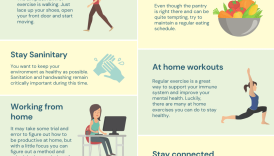Healthy Eating Habits for a Happy and Active Life

Introduction to Healthy Eating Habits
Importance of Nutrition
Nutrition plays a critical role in maintaining overall health and well-being. It serves as the foundation of our physical and mental health, influencing everything from energy levels to immune function. Think about it—when you’ve had a nutritious breakfast, you’re more likely to feel energized and focused throughout the day. Conversely, a day filled with junk food often leaves you sluggish and unfocused. What you eat drastically impacts:
- Healthy Eating Habits for a Happy and Active Life
- Introduction to Healthy Eating Habits
- Importance of Nutrition
- Benefits of Proper Diet
- Understanding Macronutrients
- Carbohydrates, Proteins, and Fats
- Importance of Balancing Macronutrients
- Nutrient-Rich Foods
- Fruits and Vegetables
- Whole Grains and Lean Proteins
- Hydration and Its Role in Health
- Benefits of Drinking Water
- Hydration Tips for an Active Life
- Healthy Meal Planning
- Balanced Meals and Snacks
- Tips for Portion Control
- Mindful Eating Practices
- Eating Slowly and Mindfully
- Recognizing Hunger and Satiety Cues
- Importance of Regular Physical Activity
- Exercise Recommendations
- How Exercise Supports Healthy Eating
- Healthy Eating Habits for Different Life Stages
- Children and Adolescents
- Adults and Older Adults
- Strategies for Overcoming Challenges
- Healthy Eating on a Budget
- Dealing with Social Pressures
- Sustaining Healthy Habits Long-Term
- Setting Realistic Goals
- Celebrating Small Victories
- Physical Health: A balanced diet can help prevent chronic diseases such as heart disease, diabetes, and obesity.
- Mental Health: Nutrient-rich foods positively affect mood and cognitive function, supporting mental clarity and emotional stability.
- Energy Levels: Proper nutrition helps regulate energy levels, allowing for better focus and productivity throughout the day.
Benefits of Proper Diet
Adopting a proper diet has a multitude of benefits that extend beyond just physical health. Personal experience shows that when individuals embrace healthy eating habits, they often notice significant improvements in various aspects of life. Key benefits include:
- Weight Management: A well-balanced diet helps in maintaining a healthy weight.
- Improved Mood: Nutritional food can lead to better emotional balance and reduced anxiety.
- Enhanced Performance: Proper nutrition is essential for athletes and fitness enthusiasts, boosting stamina and recovery.
In summary, understanding the importance of nutrition and the benefits of a proper diet lays a solid foundation for creating and sustaining healthy eating habits.
Understanding Macronutrients
Carbohydrates, Proteins, and Fats
Diving deeper into healthy eating habits, understanding macronutrients is essential. These three building blocks—carbohydrates, proteins, and fats—fuel our bodies and play unique roles.
- Carbohydrates are the primary source of energy. They can be found in foods like fruits, vegetables, and whole grains. Think of them as the gas in your car—without gas, you can’t go anywhere!
- Proteins are crucial for growth and repair. Whether it’s through lean meats, legumes, or nuts, incorporating protein helps build muscle and keeps you feeling full longer.
- Fats support cell structure and provide long-lasting energy. Healthy fats, such as those from avocados and olive oil, are vital for heart health.
Importance of Balancing Macronutrients
Balancing these macronutrients is where the magic happens. Each person’s needs will vary based on lifestyle, age, and health goals. For example:
- An athlete might require more carbohydrates for energy.
- A fitness enthusiast may need a higher protein intake for muscle recovery.
- Someone looking to lose weight might focus more on incorporating healthy fats while managing carbs.
A balanced diet can improve overall health, optimize performance, and help sustain energy levels throughout the day. It’s not just about what you eat but how you balance those foods to nourish your body effectively.
Nutrient-Rich Foods
Fruits and Vegetables
Continuing our journey into healthy eating habits, let’s explore nutrient-rich foods that should be staples in any diet. Fruits and vegetables are some of the most vital components. They are packed with vitamins, minerals, and antioxidants, which are essential for maintaining good health. Imagine biting into a crisp apple or munching on vibrant carrots; not only are you enjoying a tasty snack, but you’re also fueling your body with nutrients! Here are some standout options:
- Leafy Greens: Spinach and kale are excellent sources of iron and calcium.
- Berries: Blueberries and strawberries are rich in antioxidants and great for your heart.
- Cruciferous Vegetables: Broccoli and Brussels sprouts can help boost your immune system.
Whole Grains and Lean Proteins
Following up with whole grains and lean proteins, these foods are equally important for a well-rounded diet. Whole grains, such as quinoa, brown rice, and oats, provide sustained energy and are rich in fiber. Lean proteins, like chicken, turkey, beans, and fish, support muscle repair and keep you feeling satiated. Including these in your meals can be as simple as:
- Breakfast: Start your day with oatmeal topped with fresh berries.
- Lunch: Enjoy a quinoa salad packed with colorful veggies and grilled chicken.
- Dinner: Pair brown rice with steamed broccoli and a piece of salmon.
By making fruits, vegetables, whole grains, and lean proteins a priority, you’re setting the stage for a healthier lifestyle filled with energy and vitality.
Hydration and Its Role in Health
Benefits of Drinking Water
Just as vital as nutrient-rich foods, hydration plays an essential role in maintaining overall health. Water is often overlooked, yet it is crucial for nearly every bodily function. Think about it: when you’re dehydrated, even simple tasks can feel more challenging. Here are some notable benefits of drinking water:
- Boosts Energy Levels: Staying hydrated can improve your stamina during workouts and daily activities.
- Aids Digestion: Water helps break down food, ensuring nutrients are absorbed effectively.
- Regulates Body Temperature: Proper hydration helps your body sweat and cool down.
Hydration Tips for an Active Life
As someone who enjoys staying active, incorporating hydration into daily routines is vital. Here are some practical tips to stay well-hydrated:
- Carry a Water Bottle: Keep it with you throughout the day, making it easy to sip anytime.
- Set Reminders: Use your phone to remind you to drink water regularly.
- Infuse Your Water: Add fruits like lemon, cucumber, or berries for added flavor if plain water gets boring.
With these habits, you can easily maintain hydration, supporting not just your physical activities but your overall well-being too. Remember, keeping hydrated is one of the simplest yet most impactful steps towards a healthier lifestyle!
Healthy Meal Planning
Balanced Meals and Snacks
Building on the importance of hydration, meal planning is another cornerstone of healthy eating habits. Balanced meals and snacks ensure that our bodies receive the nutrients needed to thrive. A well-rounded plate typically includes:
- Lean Proteins: Chicken, fish, beans, or tofu for muscle maintenance and energy.
- Healthy Carbohydrates: Quinoa, whole grain bread, or brown rice as energy sources.
- Colorful Vegetables: A variety of veggies for vitamins and minerals.
- Healthy Fats: Avocados, olive oil, or nuts for heart health.
For snacks, consider options like Greek yogurt with fruit or veggie sticks with hummus. These not only curb hunger but also keep your energy levels stable throughout the day.
Tips for Portion Control
Mastering portion control is crucial for maintaining a balanced diet without overeating. Practical tips include:
- Use Smaller Plates: This simple trick can make your servings appear larger.
- Measure Portions: Get familiar with serving sizes to help gauge what’s appropriate.
- Listen to Your Body: Eat slowly and pay attention to signs of hunger and fullness.
By thoughtfully planning balanced meals and practicing portion control, you can craft a sustainable eating routine that supports your health goals without feeling deprived or overwhelmed.
Mindful Eating Practices
Eating Slowly and Mindfully
Transitioning from meal planning, one of the most impactful aspects of healthy eating is the practice of mindful eating. Eating slowly and mindfully allows us to fully appreciate our food and helps in digestion. Think back to those meals where the flavors and textures truly stood out—this happens when we take our time. To embrace mindful eating:
- Limit Distractions: Set aside screens and focus on your meal.
- Savor Each Bite: Take small bites and chew thoroughly to enjoy the flavors.
- Engage Your Senses: Notice the colors, smells, and textures on your plate.
Recognizing Hunger and Satiety Cues
Along with mindful eating, recognizing hunger and satiety cues is essential. Often, we eat out of habit rather than true hunger. By tuning into our bodies, we can make healthier choices. Consider these strategies:
- Before Meals: Pause to assess your hunger level on a scale from 1 (extremely hungry) to 10 (stuffed).
- Check In During Meals: Ask yourself how satisfied you feel after each few bites.
- Stop When Full: Learn to listen when your body signals it’s had enough.
By incorporating these mindful eating practices, individuals can cultivate a more respectful and enjoyable relationship with food, enhancing their overall nutritional experience.
Importance of Regular Physical Activity
Exercise Recommendations
Now that we’ve discussed mindful eating practices, it’s crucial to highlight the importance of regular physical activity. Exercise not only bolsters physical health but also enhances mental well-being and complements healthy eating habits. The general recommendation is to aim for at least 150 minutes of moderate-intensity aerobic exercise per week, which could include activities like brisk walking, cycling, or swimming.
- Strength Training: Incorporate strength training exercises at least twice a week to boost muscle mass.
- Flexibility Exercises: Don’t forget to include stretching or yoga to maintain flexibility and reduce injury risk.
How Exercise Supports Healthy Eating
Exercise plays a vital role in supporting healthy eating habits. When you engage in regular physical activity, your body demands energy, making you more conscious of your food choices. Consider this:
- Increased Awareness: After a workout, healthier food choices feel more rewarding.
- Enhanced Metabolism: Exercise can help regulate appetite hormones, making it easier to distinguish between hunger and emotional eating.
- Boosted Mood: Physical activity releases endorphins, which can curb cravings and reduce emotional eating.
Integrating regular exercise into your routine not only promotes better health outcomes but also strengthens your commitment to maintaining a balanced diet. It becomes a holistic approach to wellness—combined nutrition and movement leads to a more energized and fulfilling life.
Healthy Eating Habits for Different Life Stages
Children and Adolescents
Continuing our exploration of healthy eating, it’s important to recognize that different life stages come with unique nutritional needs. For children and adolescents, proper nutrition is pivotal for growth, development, and establishing lifelong habits. Encouraging healthy eating can be fun! Here are some effective strategies:
- Colorful Plates: Get kids involved in meal prep; a colorful plate of fruits and vegetables makes meals visually appealing.
- Healthy Snacks: Instead of sugary snacks, opt for options like yogurt, nuts, or whole-grain crackers.
- Educate on Choices: Teach them about food labels and the importance of balanced meals.
Adults and Older Adults
As we transition into adulthood and later stages of life, nutrition continues to play a significant role in maintaining health. For adults, balancing a busy lifestyle with healthy eating can be challenging. Here’s how to foster good habits:
- Meal Prepping: Planning meals ahead can save time and help avoid unhealthy fast-food options.
- Focus on Nutrient Density: Prioritize foods rich in nutrients, such as leafy greens, lean proteins, and whole grains.
- Stay Hydrated: Remind older adults to drink water regularly, as hydration needs can change with age.
By understanding the specific needs at each life stage and adapting healthy eating habits accordingly, individuals can promote better health and well-being throughout their lives. Establishing these habits early can lead to a brighter, healthier future!
Strategies for Overcoming Challenges
Healthy Eating on a Budget
As we delve into the challenges of maintaining healthy eating habits, one of the most common hurdles is managing costs. Healthy eating doesn’t have to break the bank; with some smart strategies, you can enjoy nutritious meals without overspending. Here are some budget-friendly tips:
- Plan Meals: Create a weekly menu to minimize food waste and stick to a shopping list.
- Buy in Bulk: Purchasing grains, beans, and frozen fruits and vegetables in bulk can save money in the long run.
- Seasonal Eating: Opt for fruits and vegetables that are in season, as they tend to be cheaper and fresher.
Dealing with Social Pressures
Alongside budgeting, social pressures can also pose challenges to healthy eating. Whether it’s dining out with friends or attending parties, staying on track can be tough. To navigate these situations, consider these strategies:
- Communicate Preferences: Let friends know your dietary choices; they might surprise you with understanding.
- Make Smart Choices: When eating out, look for healthier options on the menu or share a dish.
- Practice Moderation: You don’t have to skip dessert; enjoy a small portion to satisfy cravings without overindulging.
By employing these strategies, individuals can successfully overcome challenges associated with healthy eating, ensuring that they stay committed to their nutritional goals while enjoying life’s social moments.
Sustaining Healthy Habits Long-Term
Setting Realistic Goals
As we wrap up our discussion on strategies for overcoming challenges, let’s talk about the importance of sustaining healthy habits long-term. The first step in this journey is setting realistic goals. It’s easy to get excited and aim for drastic changes, but small, achievable goals lead to lasting results. For example:
- Start Small: Instead of swearing off all sweets, try reducing sugary snacks to a couple of times a week.
- Be Specific: Rather than saying “I’ll eat healthier,” aim for “I will include one vegetable in each meal.”
- Track Progress: Keeping a journal of your goals can help you stay accountable and visually see your improvements.
Celebrating Small Victories
Alongside setting goals, celebrating small victories is essential. Acknowledging progress, no matter how minor, fosters motivation. Consider these ways to celebrate:
- Treat Yourself: After a week of sticking to your meal plan, reward yourself with a fun outing or a new workout outfit.
- Share Achievements: Tell family and friends about your successes; their encouragement can boost your morale.
- Reflect on Changes: Note how your energy levels and mood improve; recognizing these benefits reinforces your commitment to health.
By setting realistic goals and celebrating small victories, individuals set the stage for sustainable healthy habits that can last a lifetime, making the journey enjoyable and fulfilling.





